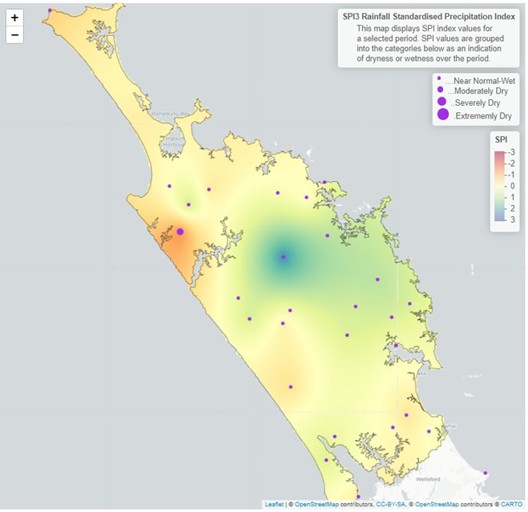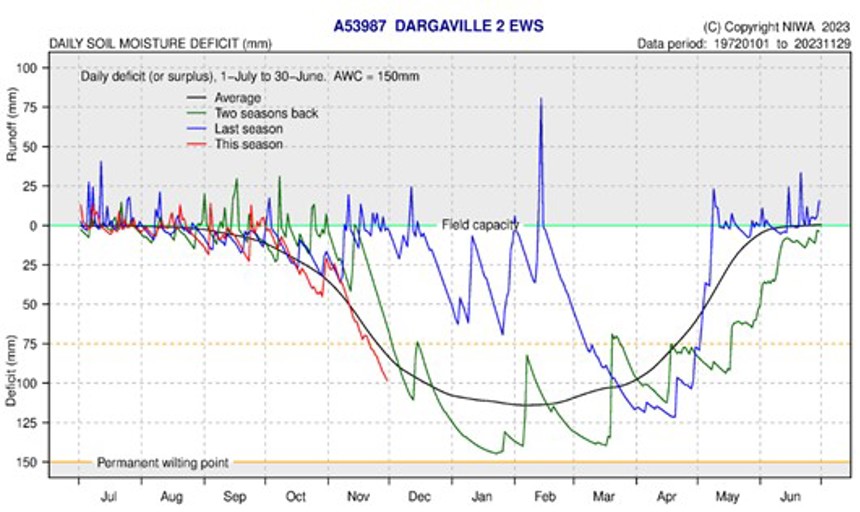November 2023 climate report
6 Dec 2023, 2:45 PM
Summary
- El Niño is set to continue but the seasons will be varied as the Madden-Julian Oscillation shifts its phase.
- High winds are likely to dominate.
- Temperatures are likely to be “above average”.
- Rainfall, flows, and soil moisture are likely to be “near average” or “below average”.
- November rainfall was less than expected with a regional average of 84%.
- Standardised precipitation on a three- and six-month scale for Northland was “near normal” with some “wet” areas.
- River flows and groundwater in November were “above normal”.
- Soil moisture is about average for Northland for November, some areas might be starting to see some plant stress as we reach 50 – 75 mm deficit in the region.
Climate Outlook
December 2023 to February 2024
El Niño conditions are set to continue throughout summer and have an 85% likelihood of persisting through autumn. However, the Madden-Julian Oscillation (MJO), Indian Ocean Dipole and unusual ocean temperatures are causing non traditional El Nino weather patterns.
There is a high likelihood of tropical cyclone development in the south pacific, driven by the MJO changing phase. This will cause variable temperatures, humidity, and rainfalls for New Zealand particularly in December. Later in the summer it is expected that the weather will become more typical for El Nino conditions, with stronger than normal nor westerly winds likely to dominate.
In Northland, temperatures are likely to be “above average” with spells of high humidity for summer. River flows and soil moisture are likely to be either “near average” or “below average”. Rainfall is expected in the first week of December, followed by drier than average rainfall.
Between December to February, it is expected that Northland will receive “Near average” or “Below average” rainfall. The Drought forecast dashboard (NZDI) utilises rainfall, soil moisture, evapotranspiration to estimate meteorological drought conditions in New Zealand. The 35 day predicted outlook to the 5th January 2024 shows a small likelihood of very dry conditions in parts of Northland (90th percentile/ 10% likelihood). Marine heat wave conditions in coastal New Zealand is low, however localised events are likely to develop particularly in the north and east.
For more details, please refer to NIWA’s seasonal climate outlook for December 2023 - February 2024:
Seasonal climate outlook on NIWA's website: niwa.co.nz
NIWA35 sub-seasonal forecast for the NZ Drought Index for December 2023 to 5 January 2024
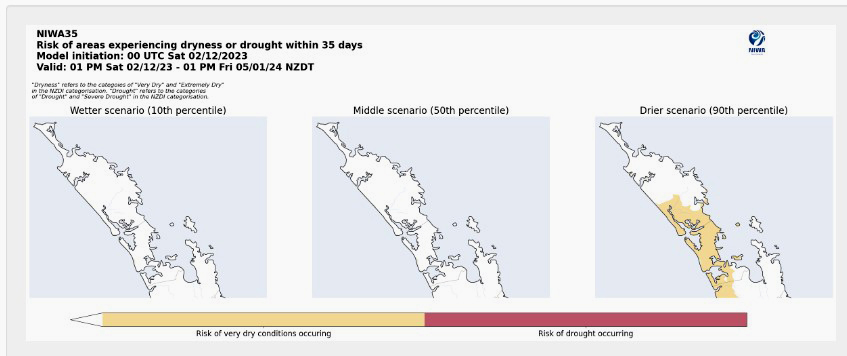
NIWA35 sub-seasonal forecast for the NZ Drought Index - 2 December 2023 to 5 January 2024. (Image: NIWA).
NIWA Temperature, Rainfall, Soil Moisture and River Flows probabilities for the period of December 2023 to February 2024
(Expressed as % likelihood for either Above Average, Near Average or Below Average conditions).
| Temperature | Rainfall | Soil moisture | River flows | |
| Above average | 55• | 25 | 15 | 15 |
| Near average | 35 | 40• | 40• | 40• |
| Below average | 10 | 35• | 45• | 45• |
Rainfall
During November, there we several scattered rain events around the region. The regional recorded average was 65 mm, which is 84% of the expected rainfall for November. The highest rainfall totals were recorded at Waimamaku 133mm and Kaikohe 124.6mm. While the lowest totals were recorded at Pouto Point 30mm and Kai iwi Lakes 31mm.
The highest percentages compared to the location average were concentrated to the east coast and central areas with 166% at Kaikohe and 134% at Ōpua. While the driest areas were in the south and west with 43% at Paparoa and 44% at Kai iwi Lakes. The varied pattern is likely to be similar in December, while the Madden-Julian Oscillation settles, however in January we are likely to see the classic El Niño pattern with the west coast receives majority of the rainfall and the eastern areas are drier.
Rainfall (% of Median) for November 2023 across Northland with a range of 166% to 43%
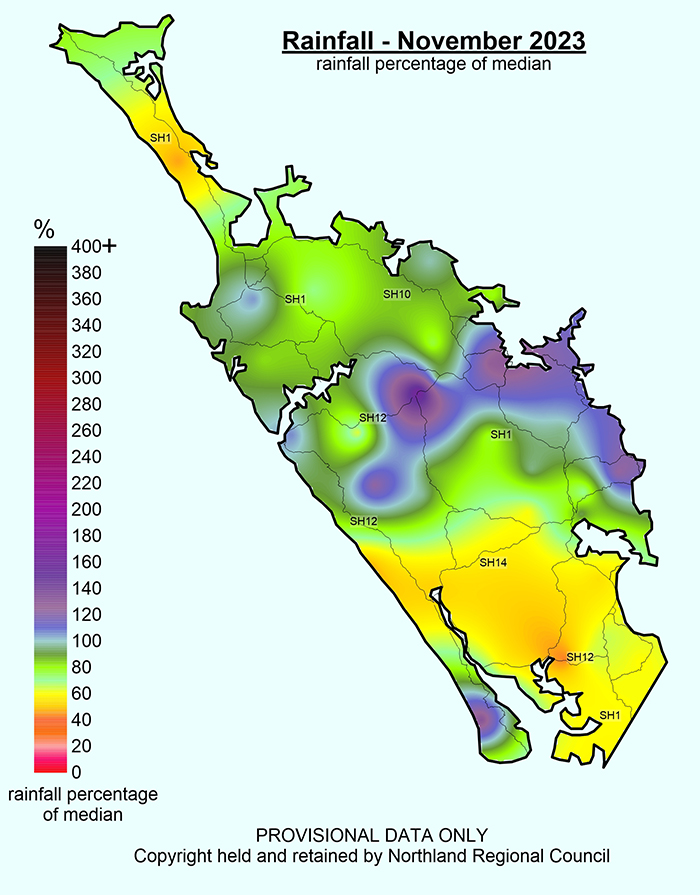
Rainfall (% of Median) for November 2023 across Northland with a range of 166% to 43%.
Standardised Precipitation index (SPI)
The Standardised Precipitation Index (SPI) on a three-month scale shows Northland is “Near Normal-Wet” with the central Kaikohe area being the wettest. The “Moderately Dry” area in the far north should be disregarded as it was caused by a blocked sensor through a rain event. Over a six month scale between June and November Northland has have “Near Normal” rainfall, with slightly wet areas in the central portion of Northland.
3-month (September - November 2023) and 6-month (June – November 2023) SPI maps
River flow
River flows varied across Northland are currently “Above Normal” for expected November flows.
Monthly percentile River Flows for November 2023
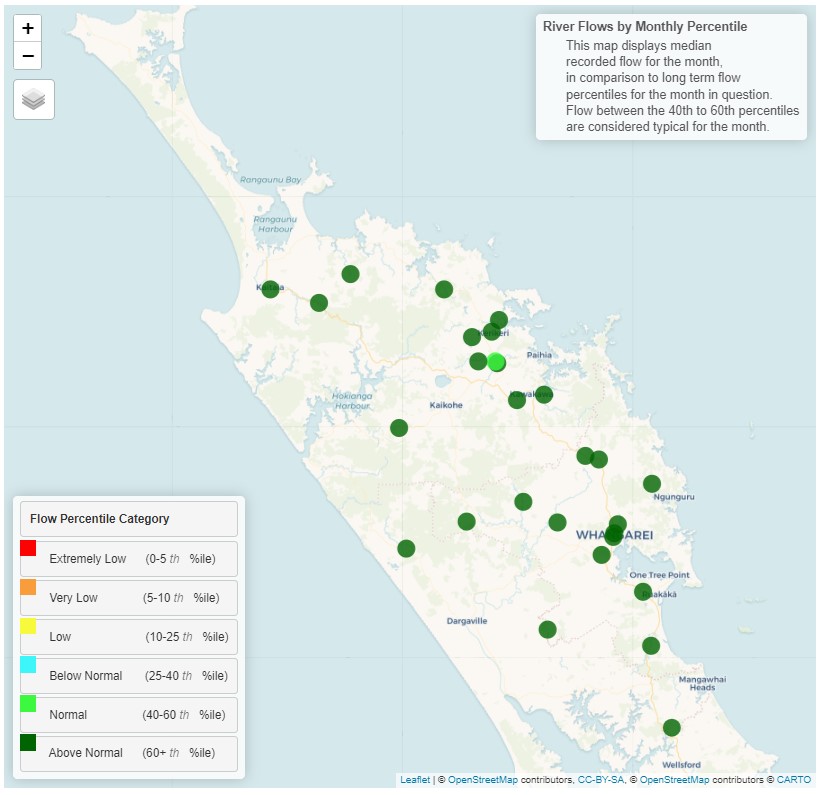
Monthly percentile River Flows for November 2023.
Groundwater
Water levels in Northland are currently recording “above normal” levels for November.
| Aquifer | Status | Percentile |
| Aupōuri | Above normal | 60th+ |
| Taipā | Above normal | 60th+ |
| Russell | Above normal | 60th+ |
| Kaikohe | Above normal | 60th+ |
| Poroti | Above normal | 60th+ |
| Whangārei | Above normal | 60th+ |
| Mangawhai | Above normal | 60th+ |
| Marsden - Ruakākā | Above normal | 60th+ |
| Ruawai | Above normal | 60th+ |
Groundwater levels for November 2023
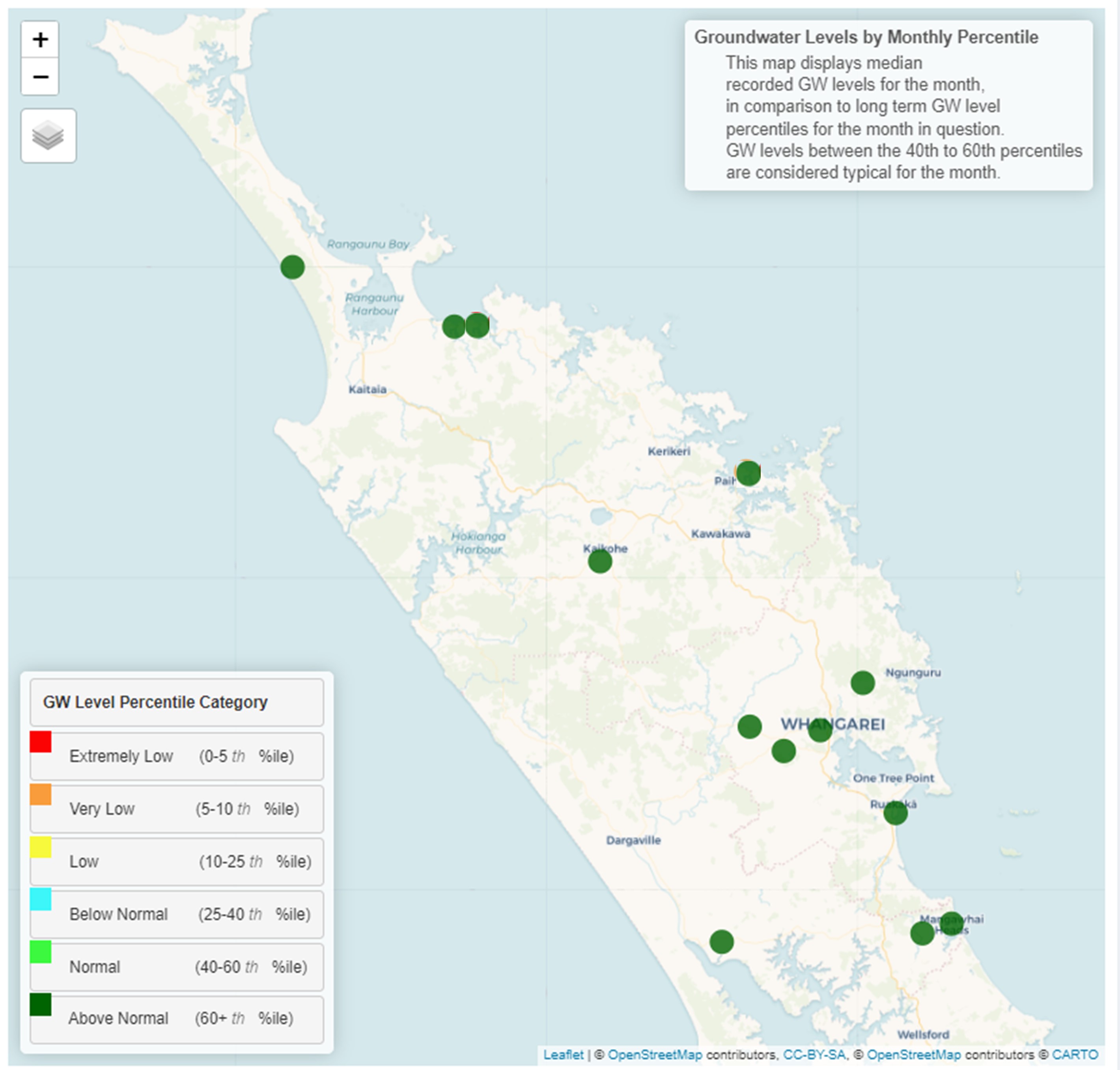
Groundwater levels for November 2023.
Soil Moisture
During November the soil moisture in Northland slowly declined into a deficit. At the end of November, the south and west were at an ≈75 mm deficit, while the eastern and northern areas had a deficit of 25 – 50 mm. Most sites monitored are at about average for this time of year.
The soil moisture deficit is calculated based on incoming daily rainfall (mm), outgoing daily potential evapotranspiration (mm), and a fixed available water capacity (the amount of water in the soil 'reservoir' that plants can use) of 150 mm” (NIWA).

